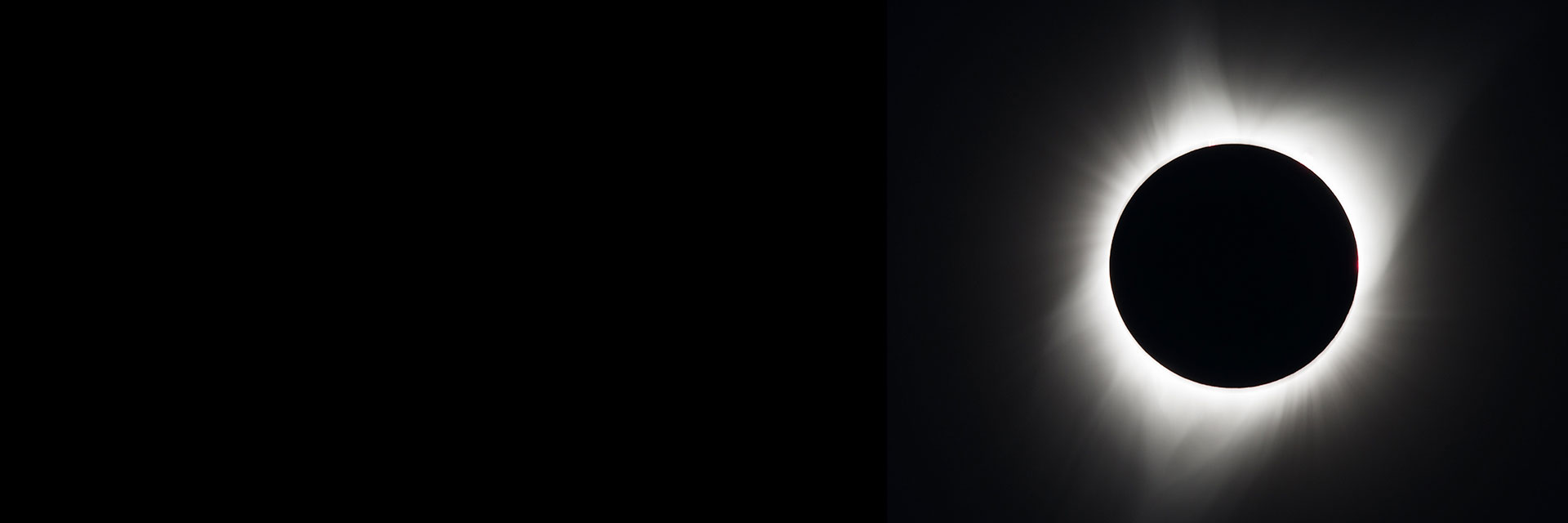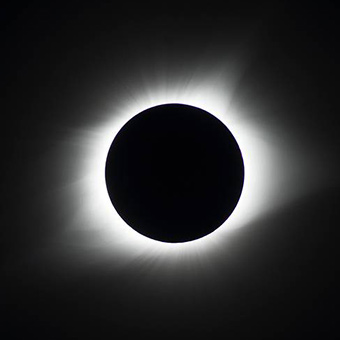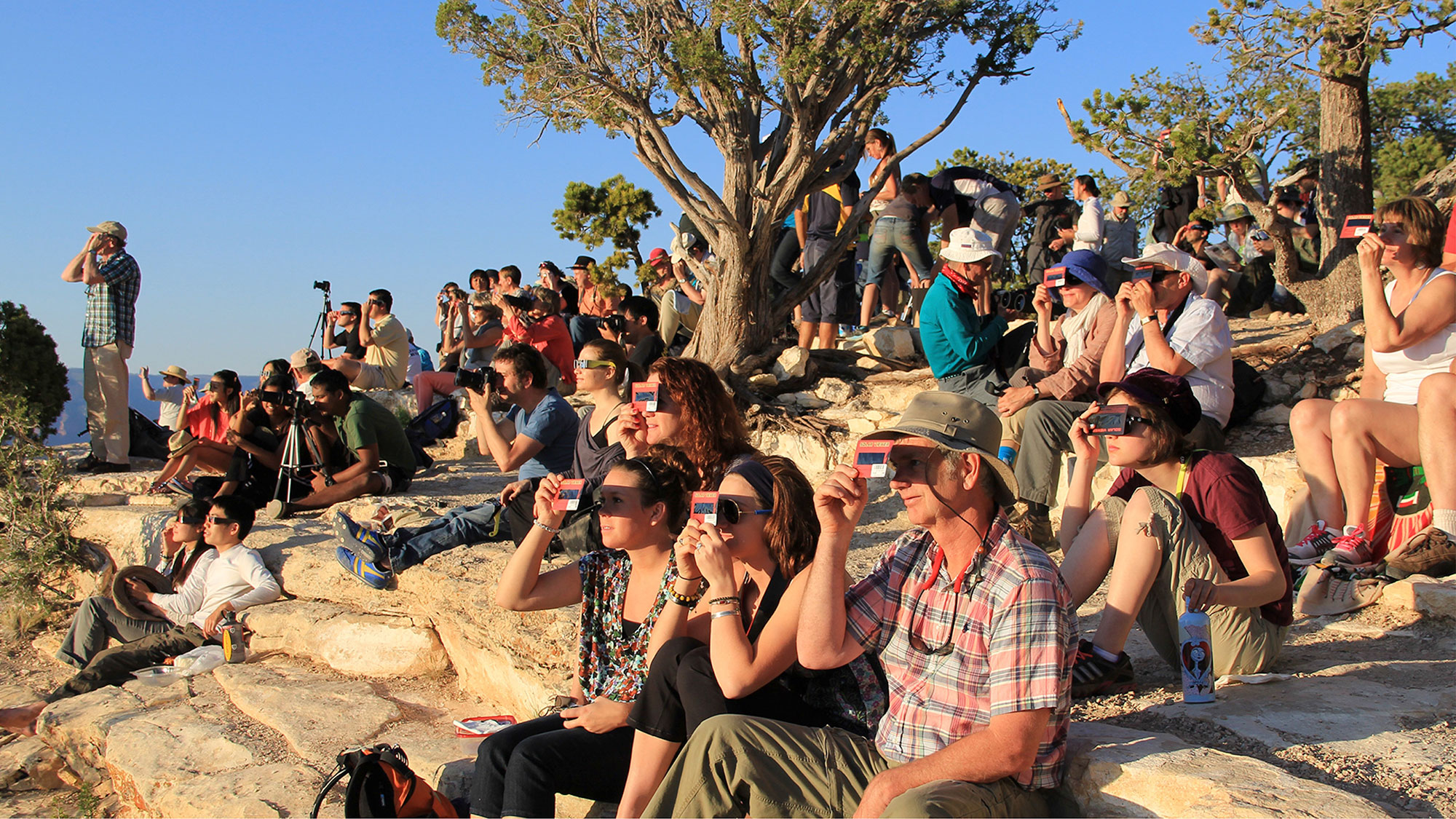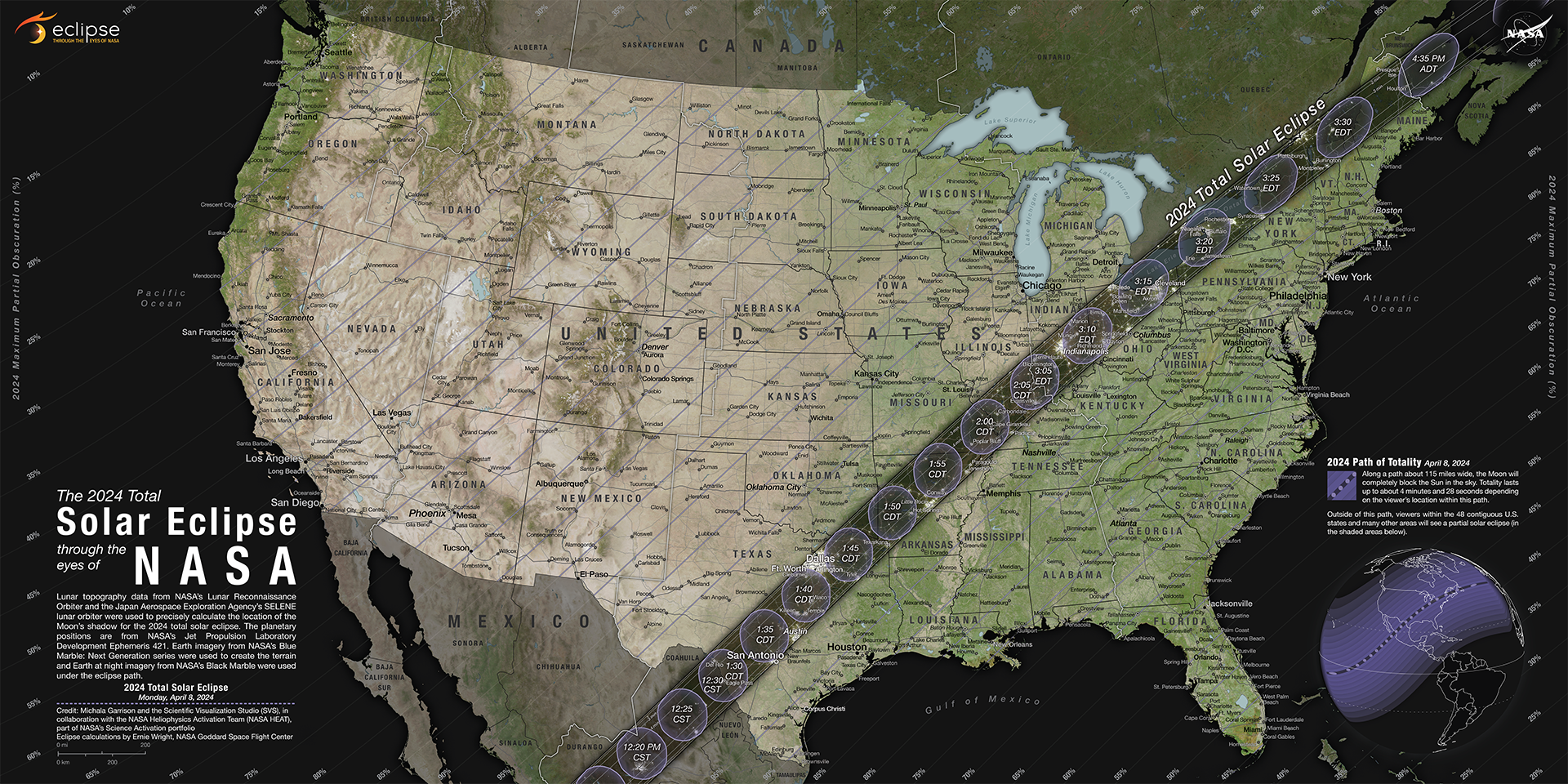General
How long will the 2024 total solar eclipse last?
The longest duration of totality is 4 minutes, 28 seconds, near Torreón, Mexico. Most places along the centerline (path of totality) will see a totality duration between 3.5 and 4 minutes.
What does the path of totality mean?
The path of totality is where observers will see the Moon completely cover the Sun.
How much will daylight change during a total solar eclipse?
In the path of totality, where the Moon completely covers the Sun, the sky will become dark, as if it were dawn or dusk. For those who only experience a partial solar eclipse, the sky will appear slightly darker than it was before the eclipse, depending on how much the Moon blocks the Sun in their location.
How big of a temperature drop do you get during a total solar eclipse?
You can expect the temperature to drop about 10 degrees Fahrenheit (5 degrees Celsius) depending on the humidity and cloud cover at your location.
What are the stages of a total solar eclipse?
During a total solar eclipse, you will see multiple unique features as the eclipse progresses.
- Partial eclipse: As the Moon passes between the Sun and Earth, at first it does not completely cover the Sun. The Sun appears to have a crescent shape.
- Shadow bands: Shadow bands are rapidly moving, long, dark bands separated by white spaces that can be seen on the sides of buildings or the ground just before and after totality, though they can be very faint and difficult to photograph.
- Baily's Beads: As the Moon continues to move across the Sun, several points of light shine around the Moon’s edges. Known as Baily's Beads, these are light rays from the Sun streaming through the valleys along the Moon's horizon
- Diamond Ring: Baily’s Beads will begin to disappear until eventually, only a single bright spot will remain along the edge of the Moon’s shadow. This bright spot resembles the diamond in a giant diamond ring formed by the rest of the Sun’s atmosphere.
- Totality: Totality is when the Moon completely blocks the bright face of the Sun. This is the only stage of the eclipse that you can view with your naked eye. This stage can also reveal the chromosphere (a region of the solar atmosphere, appearing as the thin circle of pink around the Moon) and the corona (the outer solar atmosphere, appearing as streams of white light).
After totality, viewers will be able to experience the features they saw earlier in the eclipse again. To learn more about what to expect during an eclipse, visit this page.
Safety
How do you safely view a total solar eclipse?
The Sun’s surface is so bright that if you stare at any portion of it, no matter how small, it produces enough light to damage individual retinal cells. It takes a few seconds for this to happen, but afterward, you will see a spot as big as the solar surface you glimpsed when you look away from the Sun at some other scenery. Depending on how long you gazed at the Sun and how badly the retinal cells were damaged, this spot will either fade away in time or remain permanent. You should never assume that you can look away quickly enough to avoid eye damage because every person is different in terms of their retinal sensitivity, and you do not want to risk being the one who damages their eyes just to try to look at the Sun.
If you want to see what the Sun looks like, use a properly-equipped telescope or solar viewing glasses. You could also go online and view thousands of pictures taken of the Sun by telescopes and NASA spacecraft!
Why is it not safe to look at the Sun even when only a small part of it is visible?
The rods and cones in the human retina are very sensitive to light. Normally during daylight conditions, the iris contracts so that only a small, safe amount of light passes through the lens and then reaches the retina. However, the Sun’s surface is so bright that even a thin sliver of its light can still damage the eye if you were to look directly at it. When exposed to direct sunlight, retinal cells will become damaged, sometimes permanently. This can happen even after a quick glance at the Sun so it is very important to never look at the Sun directly. To look at the Sun, use solar viewing glasses or a property-equipped telescope.
Is it true that you should not look at the Sun even during a total solar eclipse?
When the bright photosphere of the Sun is completely covered, only the faint light from the corona is visible, and this radiation is too weak to have any harmful effects on the human retina. There is a misunderstanding that during a total solar eclipse, when the Moon has fully blocked the light from the Sun, there are still harmful rays that can injure your eyes. This is false.
During other types of solar eclipses, viewers must wear solar viewing or eclipse glasses or use an alternative viewing method the entire time, as at least part of the Sun is always visible. During a total solar eclipse, viewers should take those protective measures before and after the Sun’s visible disk is completely blocked. However, once it’s completely blocked – called totality – viewers can look directly at the eclipse without any special eye protection.
How are eyes damaged by staring at the Sun?
Typically, eye damage from staring at the Sun results in blurred vision, dark or yellow spots, pain in bright light, or loss of vision in the center of the eye (the fovea). Permanent damage to the retina has been shown to occur in ~100 seconds, but the exact time before damage occurs will vary with the intensity of the Sun on a particular day and with how much the viewer's pupil is dilated from decongestants and other drugs they may be taking.
Even when 99% of the Sun's surface (the photosphere) is obscured during the partial phases of a solar eclipse, the remaining crescent Sun is still intense enough to cause a retinal burn. Note, there are no pain receptors in the retina so your retina can be damaged even before you realize it, and by then it can be too late to save your vision!
Where can I get the right kind of solar filter to view the eclipse?
For a list of trusted solar filter vendors, please see the American Astronomical Society’s website.
Is it only the bright light that is dangerous when viewing the Sun?
Although solar filters and eclipse glasses safely block the intense sunlight that is known to damage retinas, the infrared ‘heat’ from the Sun can also make viewing uncomfortable as it literally warms the eye. This is why staring at the Sun for minutes at a time even with proper filters can still overheat the tissues and fluids in the eye. The consequences of this heating can be dangerous. To avoid this problem, frequently look away from the Sun to cool your eyes while using filters.
Can I photograph the eclipse with my smartphone?
Yes, but you need to have the specialized eclipse filter between your camera and the Sun. See the American Astronomical Society website for more detailed instructions.
Resources
What eclipse resources are available for culturally responsive learning?
Eclipses hold significance across many cultures. There are multiple resources available for culturally responsive teaching. Here is a non-comprehensive list:
What resources are available for the Blind and low vision community?
Everyone can experience an eclipse.
Here are some resources for the Blind and low vision community:
- Eclipse Soundscapes in English & Espanol
- Braille Books
Science
What causes an eclipse to occur?
Eclipses occur due to the special coincidence of the Moon and the Sun being the same angular size. The Sun is approximately 400 times wider than the Moon, but it is also approximately 400 times farther away, so they appear to be the same size in our sky. This is what allows the Moon to completely block the Sun during total solar eclipses.
However, the Moon's orbit around Earth is not a perfect circle, so when it is at its farthest point from the Earth the Moon will appear slightly smaller than the Sun. Eclipses that happen during this phase of the Moon's orbit are known as annular eclipses, and the Sun is still visible in a "ring of fire" encircling the Moon.
What is the difference between a total solar eclipse and an annular eclipse?
To learn more about the types of solar eclipses, visit our Eclipse Types page.
A total solar eclipse happens when the Moon passes between the Sun and Earth, completely blocking the face of the Sun. People located in the center of the Moon’s shadow when it hits Earth will experience a total eclipse. The sky will darken, as if it were dawn or dusk. Weather permitting, people in the path of a total solar eclipse can see the Sun’s corona, the outer atmosphere, which is usually obscured by the bright face of the Sun. A total solar eclipse is the only type of solar eclipse where viewers can momentarily remove their eclipse glasses (which are not the same as regular sunglasses) for the brief period of time when the Moon is completely blocking the Sun. The next total solar eclipse in the U.S. will be on April 8, 2024.
An annular solar eclipse happens when the Moon passes between the Sun and Earth, but when it is at or near its farthest point from Earth. Because the Moon is farther away from Earth, it appears smaller than the Sun and does not completely cover the Sun. As a result, the Moon appears as a dark disk on top of a larger, bright disk, creating what looks like a ring around the Moon. The next annular eclipse in the U.S. will be on Oct. 14, 2023.
Why don’t eclipses occur every new moon?
The Moon’s orbit is "tilted" relative to the Sun-Earth line. As a result, sometimes the Moon's shadow is too high above Earth and sometimes it is too low. Other times, it is just right.
What is a sunspot?
Occasionally, dark spots freckle the face of the Sun. These are sunspots, cooler regions on the Sun’s visible surface caused by a concentration of magnetic field lines. Sunspots are the visible component of active regions, areas of intense and complex magnetic fields on the Sun that are the source of solar eruptions. Lasting from days to months, sunspots typically stretch 1,000 to 100,000 miles across. The number of sunspots goes up and down as the Sun goes through its natural 11-year cycle. Scientists use sunspots to help them track this cycle.
What is the Saros Cycle & Series?
Eclipses occur in patterns. The Saros Series is a period of 223 lunar months that has been used to predict eclipses for thousands of years. In a Saros Series, exactly 9 years, 5.5 days after any lunar eclipse, a solar eclipse will occur, and vice versa. Approximately 6585.3211 days, or 18 years, 11 days, and 8 hours after one eclipse, the Sun, Earth, and Moon return to about the same relative geometry, and a nearly identical eclipse occurs. These similar eclipses are part of the same Saros Cycle, and the time between the two eclipses is called a saros.
For eclipses that belong to the same Saros Cycle, the Moon will be at the same node and the same distance from Earth. Because one eclipse of a Saros Cycle occurs just 11 days later in the year than the last one, Earth will be at nearly the same distance from the Sun and tilted relative to it in nearly the same orientation (in the same season) as it was during the previous eclipse in that cycle. Each total solar eclipse path of totality looks similar to the previous one, but is shifted by 120 degrees westward.
Why do eclipse tracks move eastward even though Earth rotates from west to east?
Earth rotates eastward on its axis, which means the Moon, Sun, and stars appear to move from east to west across the sky. The Moon orbits Earth in the same direction as our planet rotates – eastward – but the Moon’s movement along its orbit is small compared to Earth’s daily rotation, making it difficult to notice the Moon’s eastward motion. However, during a solar eclipse, it is easier to observe this motion as the Moon crosses in front of the Sun from west to east. The Moon’s shadow follows in the same direction, tracing an eastward path across Earth’s surface.
How do modern-day scientists predict eclipses?
Astronomers first have to work out the geometry and mechanics of how Earth and the Moon orbit the Sun under the influences of the gravitational fields of these three bodies. From Newton's laws of motion, they mathematically work out the motions of these bodies in three-dimensional space, taking into account the fact that these bodies have finite size and are not perfect spheres. Scientists then feed the current positions and speeds of Earth and the Moon into these complex equations, and then program a computer to "integrate" these equations forward or backward in time to calculate the relative positions of the Moon and Sun as seen from the vantage point of Earth. Eclipses are specific configurations of these bodies that can be identified by the computer. Current eclipse forecasts are accurate to less than a minute in time over a span of hundreds of years.
How rare are total solar eclipses?
During the 5,000-year period between 2000 BCE to 3000 CE, Earth will experience 11,898 eclipses of the Sun: 4,200 partial eclipses, 3,956 annular eclipses, 3,173 total eclipses and 569 hybrid eclipses. That means that every 1,000 years there are 840 partial eclipses, 791 annular eclipses, 635 total eclipses, and 114 hybrid eclipses. That works out to 2-3 solar eclipses of all kinds each year, and about 2 total solar eclipses every 3 years.
How is a total solar eclipse unique?
A total solar eclipse happens when the Moon passes between the Sun and Earth and completely blocks the face of the Sun. People located near the center of the Moon’s shadow when it hits Earth will experience a total eclipse. The sky will become very dark, as if it were dawn or dusk. During a total solar eclipse, if skies are clear, people can see the Sun’s outer atmosphere, the corona, with their own eyes. The corona is otherwise too dim to see against the bright face of the Sun. A total solar eclipse is the only type of solar eclipse where viewers can momentarily remove their eclipse glasses (not the same as ordinary sunglasses) for this brief period of time when the Moon is completely blocking the Sun. This is what will happen in the U.S. on April 8, 2024.
Why do NASA scientists study solar eclipses?
NASA scientists study eclipses to make new discoveries about the Sun, Earth, and our space environment. Total solar eclipses are particularly important because they allow scientists to see a part of the Sun’s atmosphere – known as the corona – that’s too faint to see against the bright light of the solar disk. Learn more about how NASA scientists study eclipses.
How is the Sun completely blocked in a total eclipse?
Eclipses occur due to the special coincidence of the Moon and the Sun being the same angular size. The Sun is 400 times wider than the Moon, but it is also 400 times farther away, so they appear to be the same size in our sky. This is what allows the Moon to completely block the Sun during total solar eclipses. An activity that demonstrates this effect can be found here.





